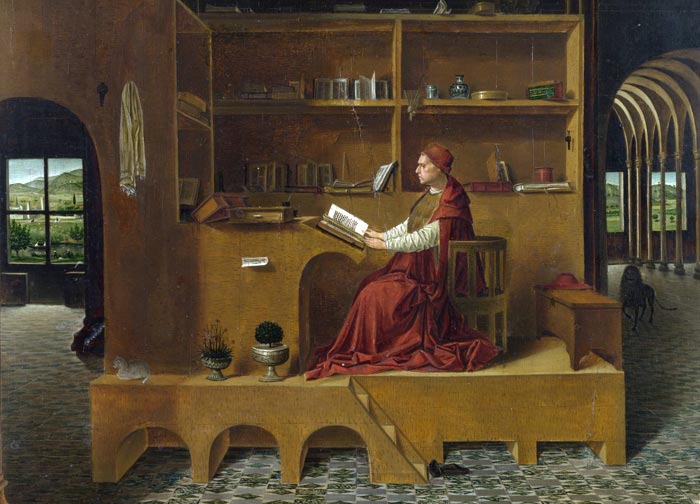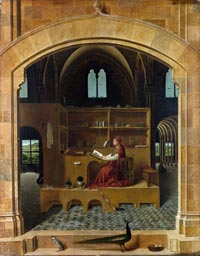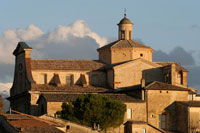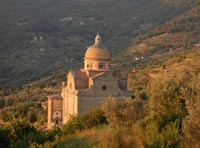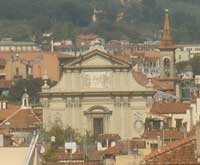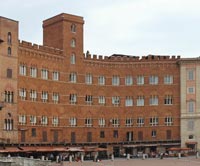|
| The painting is recorded in a Venetian collection in 1529 as by Antonello, Van Eyck or Memling. Antonello may have painted it when in Venice in the 1470s. His style was much influenced by Netherlandish painting seen in the detailed treatment of objects such as the hanging towel and the view through the window. The 4th-century Saint Jerome was one of the four Fathers of the Church, and is often represented in the Renaissance. He was famous for the Vulgate — the translation of the Bible into Latin — and is often depicted in his study. A painting of Saint Jerome, thought to be by Jan van Eyck, is known to have been in Naples in 1456 and Antonello may have seen it. He certainly worked in Naples as well as his native Sicily. Saint Jerome in his Study is one of the most famous of the artist's mature works. The painting which Marcantonio Michiel - a cultivated art connoisseur - saw in 1529 in the house of a rich merchant Antonio Pasqualigo, clearly shows why the Venetian aristocrats competed to acquire Antonello's portraits and small devotional paintings as soon as the artist from Messina set foot in Venice. The ingenious architectural setting in this picture must immediately have appeared an unprecedented novelty to everyone, with Jerome's study inserted into a powerful, dark church, rather like a set of Chinese boxes, backlit from windows opening onto an airy rural landscape. The Saint Jerome, with its silent luminosity, its minute descriptive detail, the highly skilful syntax of perspective obtained through the light that makes everything clear and limpid, must have been admired as an absolute masterpiece, on a par with the great Flemish painters such as van Eyck or Memling, to whom it has sometimes been attributed. |
||
| Antonello da Messina mastered the art of oil painting during Alfonso V's reign. He established himself as one of the Quattrocento's brightest painters. Antonello's imaginative compositions, characterized by French and Flemish influences, were not to be surpassed by those of any other Southern Italian painter of the Fifteenth Century. The scant available documentation about Antonello's early training reveals that he was an apprentice to the oil painter Niccolò Colantonio (born ca. 1420) in Naples sometime between 1445 and 1455. If the superbly calibrated Saint Jerome marks the artist's maturity, the fundamental components of Antonello's artistic formation can be seen in the works of the Neapolitan painter Colantonio. The young Messina artist trained in his workshop during the period in which Naples was one of the artistic capitals of the Mediterranean, during the reigns of Renato of Anjou and Alfonso of Aragon. Saint Jerome compiled the standard (Vulgate) translation of the Bible into Latin and, according to a legend, extracted a thorn from a lion's foot. This image shows the books and furniture of traditional scholarship in the mid fifteenth century. A manuscript volume, written in two columns per page, with rubricated initials and marginal glosses, lies open on the sloping part of the desk, above which are the implements of the writer. The other volumes piled haphazardly on their sides along the shelves are all large, with solid bindings and clasps. The chest would also have served for book storage. |
| [1] Antonello da Messina's short life (c. 1430-1479) remains mostly a mystery. Conjectures more than hard fact make up what little we know about the artist's existence. What is more, the Messina earthquake of 1908 destroyed what little archive documentation had been in our possession, not to mention at least one important masterpiece. We do know that, mid-fifteenth century, in a region with no particular artistic history or tradition, a veritable star sprang onto the era's art scene. He had a family-run studio – the only prestigious one between Naples and Palermo at the time – that primarily produced standards for various brotherhoods and lavish altars for churches and convents, but also striking portraits and miniatures, whose originality gained him fame as far away as Venice and Milan . That renown led him, towards the end of his brief life, to spend almost two years in Venice , where he worked hard on public and private commissions that served to confirm his undeniable greatness and immense talent. Just a few years after returning to Sicily , the brilliant artist died. But not before completing other masterpieces, recognizable as his for their successful synthesis of light and space and for their perfect balance between natural truth and ideal beauty, between reality and history, between northern European and Italian styles that represents the height of his genius. In the end, sadly, fewer than 50 paintings remain by the Sicilian master. In 1953 an exhibition in Messina gathered approximately half of these, but since then no gallery has tried to bring together all the artist's recognized masterpieces. They are spread all over the world and often extremely fragile. On the other hand, art historians have dedicated themselves increasingly to the study of the brilliant if troubled artist, and advanced research has led to new theories, historical recreations and critiques of his art, life and times. [2] Colantonio (born Niccolò Antonio, c. 1420) was an Italian painter, known mainly for having been trainer to Antonello da Messina. Details of his life are obscure. Colantonio's style was profoundly shaped by Flemish influence. Colantonio flourished in Naples between 1440 and 1470. He was a student of René d'Anjou. His paintings show the mingling of several cultures, as Alfonso V of Aragon had brought to Naples artists from Iberia, Burgundy, Provence, and Flanders. He synthesised his own style from all these sources and he was one of the first artists in Southern Italy to learn Flemish oil painting techniques. He may have learnt these techniques from the Flemish artist Barthélemy d'Eyck — a putative relative of Jan van Eyck — who seems to have been in Naples around 1440. His most notable work is St. Francis consigns the Rule to his followers (dated to 1445). This painting—for the altarpiece of a transept chapel—was inspired by a late thirteenth century fresco above the door of the Chapter House of San Lorenzo Maggiore in Naples, showing the saint giving his Rule to the Minor Friars and the Poor Clares. The fresco can be seen in the monastery Museum. The painting hangs in the Museo di Capodimonte in Naples with other examples of his work. As well as teaching the Sicilian Antonello da Messina, Colantonio may have taught the Spaniard Pedro Berruguete. |
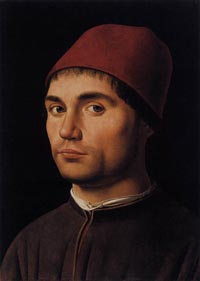 Antonello da Messina, Ritratto d'uomo (forse autoritratto), 1475 ca., Londra, National Gallery Antonello da Messina, Ritratto d'uomo (forse autoritratto), 1475 ca., Londra, National Gallery |
|||
|
||||
|
This article incorporates material from the Wikipedia article Antonello da Messina published under the GNU Free Documentation License. |
||||
|
||||
Montefalco |
Podere Santa Pia, garden view, December |
Podere Santa Pia | ||
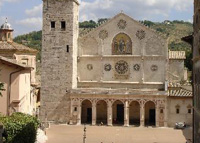 |
||||
The abbey of Sant'Antimo |
Cortona |
Spoleto, Duomo |
||
San Marco a Firenze |
Siena, Palazzo Sansedoni |
Firenze, Duomo |
||

